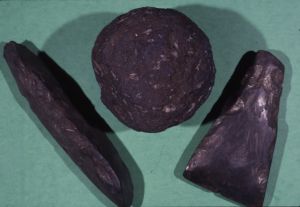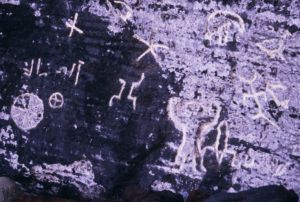Pitcairn's Earlier History: Before the MutineersWhen they arrived at Pitcairn in 1790, the Bounty mutineers found and largely destroyed a number of structures they found laying about that had been left by those who had earlier occupied the island.  The weight of archaeological evidence suggests that those who had inhabited the island were probably Polynesians. As an ever greater number of archaeologists visited the island, many other relics, particularly those that had been buried, were found. The weight of archaeological evidence suggests that those who had inhabited the island were probably Polynesians. As an ever greater number of archaeologists visited the island, many other relics, particularly those that had been buried, were found. According to Andrew Sharp, writing in his Ancient Voyagers in the Pacific,“There were three lots of stone works (found on Pitcairn), at least one of which was associated with burials. Included in the burials were bits of pearl shell which must have come from the islands to the north. There were a number of adzes made of the local stone, many of them well executed, in which one type predominated, but with others comprising many different features of construction.” Sharp notes that some of the adzes resembled those found in such distant places as Hawaii and Samoa.  Additionally, on their arrival on the island, the mutineers found crude rock drawings, and small-and medium-sized stone images done in Polynesian style. Breadfruit trees totaling more than 300 were also found on Pitcairn. Additionally, on their arrival on the island, the mutineers found crude rock drawings, and small-and medium-sized stone images done in Polynesian style. Breadfruit trees totaling more than 300 were also found on Pitcairn. No one has yet determined where the pre-mutineer inhabitants of Pitcairn came from, yet the fact that most of the items found are Polynesian in style suggests they may have come from relatively nearby islands. Honore Laval, a 19th century missionary who collected material from Mangareva, only 300 miles from Pitcairn in the Gambier Islands, found references to Mataki-te-rangi, a traditional island which one of the early chiefs of Mangareva is described as colonizing and planting with breadfruit. According to Sharp, “Mataki-te-rangi is described as being ‘like Petania,’ or ‘in truth Petania.” This was the late Mangaravan name for Pitcarin, after both islands - Mangareva and Pitcairn - had been discovered by the Europeans.” This has led some to believe that Mangarevans were the earlier inhabitants of Pitcairn. Since Pitcairn is within a few hundred miles of many inhabited islands, it is possible that those who came might have done so by canoe on fishing expeditions. It is speculated that some of these people might have chosen to stay on Pitcairn as a place of temporary inhabitation of varying lengths of time. According to archaeological findings on the island, great age is demonstrated in the items found. But also some differences in the findings - particularly in the different workings of the numerous adzes found - may suggest that different people from different points of origin may came to Pitcairn at different times in the past. Thus it is that like so much of Pitcairn’s past, mystery seems to be the master of the matter. --Herbert Ford, PISC Director | 




